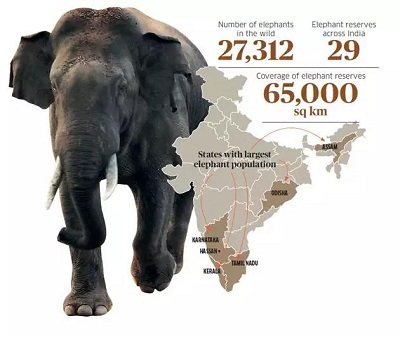Context:
Elephant deaths on and near the state's railway tracks are rising, with 36 fatalities recorded from train collisions in the past decade, according to official data.
The State of Elephants in India
Elephants are keystone species and are designated as the Natural Heritage Animal of India. The elephant population in India stands at 25,000 to 30,000, earning the species an “endangered” status. Their range today is estimated to be only 3.5% of what it was earlier, being restricted to the Himalayan foothills, the northeast, some forests of central India, and hilly forests of the Western and Eastern Ghats. Karnataka is home to the highest number of these elephants in the country.
Conservation Status
Elephants are protected under various international and national conservation statuses:
- Convention on the Migratory Species (CMS): Listed in Appendix I
- Wildlife (Protection) Act, 1972: Included in Schedule I
- International Union for Conservation of Nature (IUCN) Red List:
- Asian Elephant: Endangered
- African Forest Elephant: Critically Endangered
- African Savanna Elephant: Endangered
- Asian Elephant: Endangered
Concerns Related to Elephant Sustenance in India
Habitat Fragmentation
Of particular concern is the fragmentation of their habitat: small, forested areas providing sustenance for elephants, interspersed with human-developed landscapes. Fragmentation can also lead to restricted breeding choices. This creates genetic bottlenecks and, in the long term, a reduction in the fitness of the herds.
Elephant Movement and Human Hazards
Frequent movement of elephants between their habitable zones brings them into contact with roads and railway lines. The range of a female elephant covers about 500 sq. km, and travelling over such distances in the age of fragmented habitats makes a road or railway crossing very likely.
Fortunately, not all elephant tracks pose these hazards. The elephants of Bandipur, Mudumalai, and Wayanad go on a seasonal summer migration. They head for the Kabini Dam backwaters for both water and green grass. Studies have identified that 18 elephant routes exist between Tamil Nadu and Kerala.
Other Concerns Related to Elephant Deaths
Humans and animals often compete for the same resources, like water and food. This competition can become more intense with factors like climate change affecting resource availability. Animals may raid crops or livestock for sustenance, causing economic hardship for humans. Human activities like hunting or habitat destruction can disrupt the natural balance between predators and prey. This can lead to population booms in prey species, which in turn may raid crops or compete with humans for resources.

Solutions to Mitigate Elephant Deaths
Wildlife Corridors
Wildlife corridors are a solution—these managed lands allow for migration with minimal human contact. One good example is the Motichur-Chilla corridor in Uttarakhand, which allows the flow of elephant genes between the Corbett and the Rajaji National Parks. However, there is always the risk of conflict with humans, with elephants occasionally feasting on crops, or crossing roads and railway tracks.
Mitigating Train-Animal Collisions
In a Canadian study attempting to mitigate animal-train collisions, train-triggered warning systems comprising flashing lights and bell sounds were installed at various locations along the tracks. These signals, activated 30 seconds before train arrival, were aimed at conditioning animals to associate the warnings with approaching trains.
Animal Warnings
Cameras recorded animal responses to trains with and without warning signals, on both straight and curved tracks. Large animals, such as elks (from the deer family) and grizzly bears, left the tracks about 10 seconds before the train arrived when there was no warning system, and about 17 seconds before the train arrived when warning bells and lights were deployed (Transportation Research, vol 87, 2020).
The response to an approaching train is less in curved sections of the track, probably due to reduced visibility. In such places, sound is used by animals. However, the ability to hear an approaching train is significantly influenced by factors such as high train speed.
AI Methods for Train Speed Regulation
When should an engine driver reduce speed when passing through forests that are elephant habitats? The Indian Railways has a vast network of Optical Fiber Cables (OFC). These support telecommunications and carry data, and importantly transmit signals for train control. In a recently introduced system called Gajraj, geophonic sensors on these OFC lines are tuned to pick up the vibrations of the deep and resonant footsteps of passing elephants.
This AI-based intrusion detection system analyses data from the sensors, extracting relevant features such as frequency components and duration of vibration. If elephant-specific vibrations are detected, an alert is promptly sent to locomotive drivers in the area, and train speeds are reduced. The system is now operational in the Alipurduar area of north West Bengal, which has been the site of several tragic accidents in the past.
Conclusion
AI is emerging as a powerful ally in the fight to save elephants. From sophisticated monitoring and anti-poaching measures to mitigating human-elephant conflict, AI offers a suite of innovative solutions. However, successful implementation requires overcoming challenges like data availability, infrastructure limitations, and ethical considerations. The future of AI in elephant conservation is bright, with possibilities extending to anti-snaring measures, disease detection, and disrupting the illegal ivory trade. Ultimately, by harnessing the power of AI alongside traditional conservation methods and strong community partnerships, we can create a future where these magnificent creatures continue to roam the Earth for generations to come.
|
Probable Questions for UPSC Mains
|
Source: The Hindu







